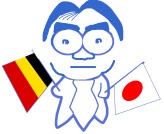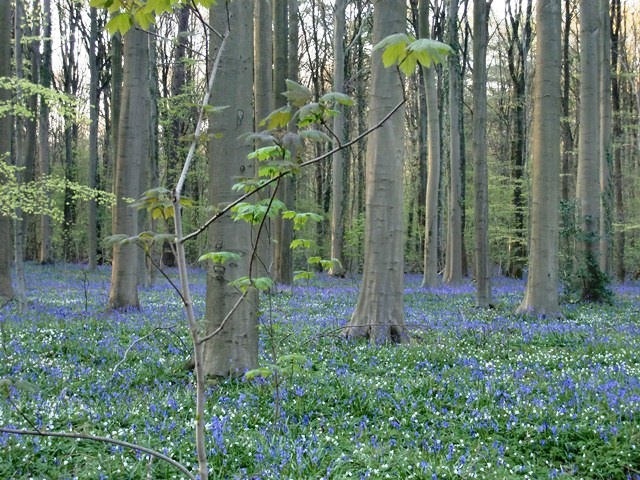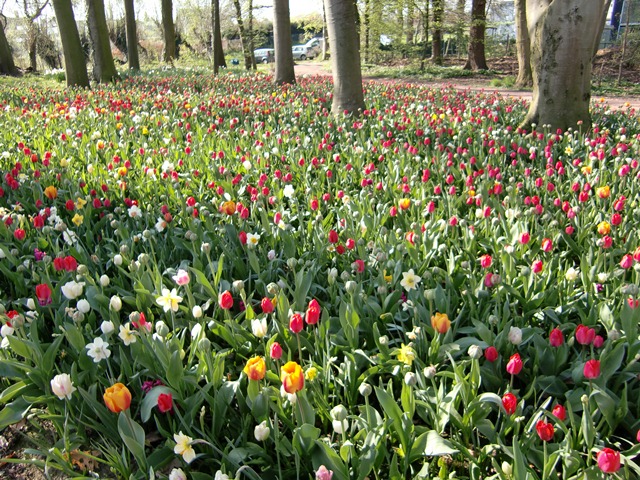Love Letter from Brussels

Spring in Full Bloom (No.15)
7th of May 2015
Wherever one looks, spring is in full bloom. Until quite recently, Belgium was a gloomy, rainy place, but now the temperature sometimes comes close to 20 degrees and in forests and gardens of houses one can see flowers in a variety of colors blooming. Of course Belgium’s weather does sometimes meet our “expectation” with its sudden drops of temperature or its rain and hail. Nevertheless, spring has certainly arrived.
In the second half of April there were several occasions for viewing flowers. First of all, there is the forest of Halle. Some 30 minutes by car to the southwest of Brussels lies the forest of Halle. There, once a year between the middle and the end of April, one can see wild hyacinths called “Blue Bells”. As the name suggests, these are blue, or rather purple, bell-shaped flowers, and the sight of them abundantly growing everywhere makes one feel like being in a sort of haze; it’s magical. This forest is perfect for taking a walk and there is no entry fee.
Next is Brussels Floralia. Once a year around this time, the castle of Groot-Bijgaarden, on the outskirts northwest of Brussels, opens its garden and greenhouse to the public. The highlight is seeing the tulips in full bloom; it is said that there are one million bulbs. Apart from these, also the crocuses and daffodils are wonderful. By the way, here there is an entry fee: 12 euro for adults.
Speaking of floralia (flower show), the most famous one in the world is perhaps the Chelsea Flower Show in Britain, but here in Belgium it must be the Ghent Floralies. This flower show, taking place in Ghent every 5 years, was first held in 1808, more than half a century earlier than the one in Chelsea and next year in 2016 will be the 35th edition (the Chelsea Flower Show was first organized in 1862 and is recently held every year. Next year will be the 94th edition). As next year coincides with the 150th anniversary of the establishment of Japanese-Belgian diplomatic relations, Japan has been invited by this historic flower show to be the guest country of honor. Theme of Japan will flourish in one of the 4 venues, focusing on Japanese traditions, such as ikebana. The event will be held next year from April 22nd until May 1st. A few weeks ago, I attended the announcement ceremony to which I had been invited by the organizing committee. I am already looking forward to Ghent being completely packed with flowers.
Tickets are already available, ranging from 32 to 35 euro for a day pass. By the way, the entry fee for this year’s Chelsea Flower Show is 46 to 69 pounds for members and 99 pounds for non-members (discounted tickets, for example for afternoon entry, are also available). Recently, 1 pound equals approximately 1.35 euro, so Ghent is much better deal for money.
(Homepage of Ghent Floralies: http://www.floralien.be/en )Talking of flowers this time of year, one cannot forget the Royal Greenhouses of Laeken. On the premises of the Palace of Laeken where HM the King and his family spend their daily life, a splendid complex of huge greenhouses was built in 1880 for King Leopold II. The greenhouses were designed by Alphonse Balat, teacher of Victor Horta, the famous representative of Art Nouveau, and are opened to the public every year only around this time for a few weeks. Of course, the view of many different varieties of flowers in bloom, including tropical plants, is wonderful, but above all, it is the harmony evoked by the curvilinear beauty of the glass and steel frame which does not look as though it was built in the 19th century, that is worth a visit. In a part of the Royal Palace’s premises, there is a Japanese-style five story pagoda and an Oriental pavilion. By the way, the entrance fee for the Royal Greenhouses is 2.5 euro per person. Compared to the Chelsea Flower Show or the Ghent Floralies –which have no option but to think about making a profit- the scale is different, but with this unbelievably low entry fee one can have a fulfilling half day, making this a place I highly recommend.
Speaking of which, Japan is on the whole said to be an expensive country. Even in Belgium people often say that “the high cost in Japan for hotels and so on makes it difficult to go travelling there”. However, is this really the case?
To cite a familiar as well as common example, let’s compare museums. The entrance fee for a special exhibition at the National Museum in Ueno, Tokyo, costs about 1400 to 1600 yen (assuming 1 euro equals 134 yen, this amounts to 10.45 - 11.85 euro). When I was in Japan I thought of it as being quite expensive. On the other hand, the special exhibition on Chagall that is currently on display at the Royal Museum of Art in Brussels costs 17.50 euro (2,345 yen). By the way, the entrance fee for the British Museum is 14 pounds (1 pound equals 182 yen, so 14 pounds is 2,548 yen). Everyone, by all means, please enjoy the museums in Japan!
Back to the flower shows, what about Japan? Although quite difficult to compare because of the different scale, for example, the entrance fee to Shinjuku Gyoen National Garden, which is well-known for its cherry blossoms and which also has a greenhouse that has been reopened after renovation, costs 200 yen (1.49 euro). This is cheaper even than the greenhouses of Laeken. Belgium friends, please do come to Japan!


